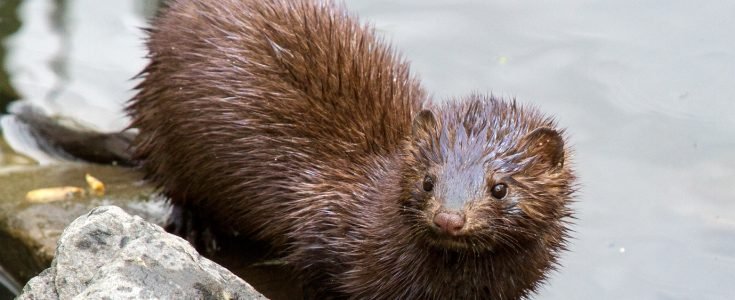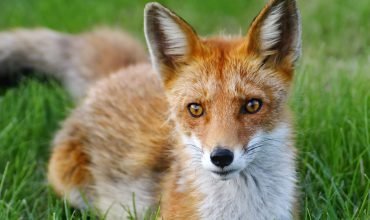American mink (Neovison vison)
Head-body/nose to tail length: males 34-54/49-75cm, females are around 10% smaller than males (30-45/44-65cm).
Weight: 0.5-1.5kg with females weighing 50% less than males.
In the wild
The American mink is a small carnivorous mammal with a long slender body, short legs and a long tail characteristic of the mustelid (weasel) family to which it belongs.
The coat is commonly dark brown, although several colour mutations (albino, tan, blonde) occur occasionally. Through selective breeding, fur factory farmers have produced several colour variations not seen in the wild.
The mink is adapted for a semi-aquatic lifestyle. The coat has three times the density of guard hairs compared with that of the terrestrial ferret and each guard hair is surrounded by 9-24 underfur hairs. Their feet have small but obvious webbing between the digits. Mink move on land with a walking or bounding gait and are also able to climb and jump well. They can dive to depths of 5-6 metres and swim underwater for up to 30-35 metres.
The native range of American mink covers most of North America except the extreme north of Canada and arid areas of the south-western United States. However, escapees from fur farms have established populations in much of northern Europe and Russia. Mink occupy a wide variety of wetland habitats, including streams, rivers, lakes, freshwater and saltwater marshes, and coast lines, and their territories always run along the edges of water bodies. There may be some territory overlap between mink of the opposite sex but territories of animals of the same sex rarely overlap. Mean linear home range size ranges from 1.1 to 7.5km, depending on sex (generally larger for males than females) and habitat.
Mink often have half a dozen, and sometimes as many as two dozen, dens used for sleeping and resting, eating larger prey items and caching surplus food. These are generally <2m from water and are usually crevices between tree roots or abandoned burrows of other species. Mink are mostly nocturnal (active at night) or crepuscular (active at dawn/dusk) but can also show a significant amount of diurnal (daytime) activity, particularly where they are more reliant on aquatic prey. Nightly movements range from zero to 12km and mink may spend 80-95% of their time inside dens.
Mink are strictly carnivorous: their diet varies according to prey availability, and typically consists mostly of fish, amphibians, crustaceans and small mammals, and opportunistically includes birds and their eggs, reptiles, aquatic insects, earthworms and snails.
Most foraging activity is along waterways. On land, mink typically hunt with their nose to the ground, poking into crevices, under boulders and into burrows. Both on land and in water, prey are caught with short bursts of activity rather than sustained pursuit.
Adult mink are generally solitary. Males and females associate briefly for mating in early spring and on average four kits (range two to eight) are born in late spring. They are nutritionally independent by eight to ten weeks of age and typically begin to disperse when around 12-16 weeks old, although young females may stay with their mother until they are ten or 11 months old and kits of either sex may travel in pairs until late autumn. Juveniles may travel a few kilometres up to 50km in search of their own territory.
American Mink and The Fur Trade

In the EU, over 41 million mink were killed for fur production in 2014. Nearly 18 million were bred and killed in Denmark alone. The next largest European mink fur producers were Poland (7.8 million) and the Netherlands (5.5 million). China accounts for around 40% of mink pelt production, with around 35 million in 2014. Globally, during the 2013/14 fur auction season, 87.2 million mink pelts were produced at a value of over 3.7 billion Euros.
Mink on fur farms are essentially wild animals. This is because domesticated mink have differences in their coats which are unsuitable for the fur industry’s demands. The undomesticated mink are not adapted to close human contact and are not adapted to a life in a cage. Indeed, animal welfare scientists say that: ‘fear of humans in the undomesticated animals used by the fur industry makes them fundamentally unsuitable for farming’
The cramped and unstimulating cage environment found in mink fur factory farms leads to the development stereotypies, self-mutilation and aggression. Stereotypies are caused by frustration of highly motivated ranging and foraging behaviours, repeated attempts to cope with adverse conditions or abnormal brain development in the highly restrictive cage environment.
These abnormal behaviours are indicative of poor welfare and conditions. Mink experience real suffering housed in these conditions
Mink are mostly killed by gassing. Either carbon dioxide (CO2) or carbon monoxide (CO) is used. A mobile gassing unit is moved along the shed and the mink are taken from the cage and put in the killing box one after another. Between 30 and 100 mink may be in the box at any one time. The close confinement with so many other animals is likely to cause severe stress.
Mink respond to CO2 with coughing and sneezing and scientists have calculated that they experience at least 10-15 seconds of pain before loss of consciousness. The EU permitted CO2 concentration is 80% – which will kill mink in an average of 4-5 minutes.
Shockingly, there is no EU requirement for personnel carrying out the killing to be trained or qualified. Reviews of the scientific evidence have condemned these killing methods as inhumane and causing real suffering.
For more information about the conditions in fur factory farms see our new report here.
The American mink can now be found in much of Northern Europe (including the UK and Ireland) and Russia where, as a non-native species, it has had a detrimental impact on the ecology of many areas. The irresponsible introduction of the species is as a result of escapes from fur factory farms or the deliberate release by fur breeders or trappers. In 1933, Russian fur trappers began to release American mink into the wild to provide a ‘free-range’ source of animals for future trapping. By 1948 some 3,700 animals had been released.
The larger American mink is now one of the main threats to the survival of it’s smaller cousin, the European mink (Neovison lutreola) which is threatened with extinction.
The breeding of mink for their fur is now banned in a number of countries, including the UK. During the debate in the Scottish parliament’s Rural Affairs Committee (28 November 2000) which led to the ban there, one member – Alex Fergusson – said ‘I come from an area in which there used to be a mink farm. When mink farming became unprofitable, the owner simply opened the doors of his cages and let the mink go.’
The fur trade is responsible for widespread and serious environmental damage around the world of which the release of alien species is just one example.




